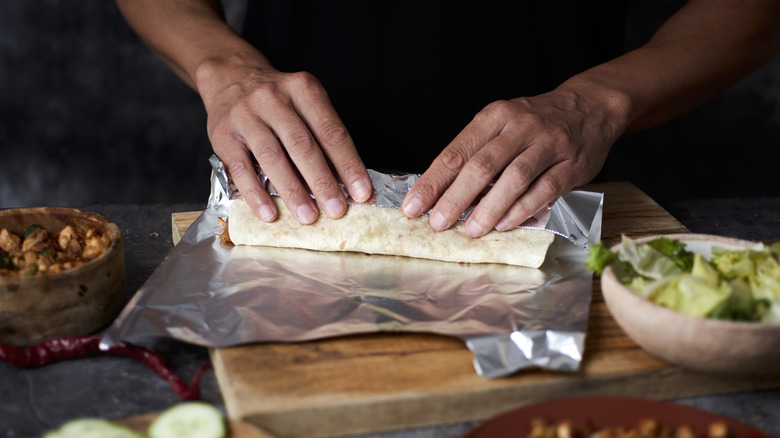Why Your Foil-Wrapped Frozen Food Turned Slightly Blue
Aluminum foil or tin foil can be found in almost every kitchen alongside a roll of plastic wrap. The thin sheet of metal was invented in 1912, reports "Antimicrobial Food Packaging" (via ScienceDirect), with the original function of packaging candy and gum. The boxes of heat-safe foil we use today weren't created until 1949. Made out of rolled out alloyed aluminum, the sheets are now used for a variety of reasons, like lining baking sheets and pans, as well as covering food so it doesn't burn while cooking.
Aluminum foil is also an incredibly useful material for covering and storing leftovers. As Recipe Tips explains, aluminum foil is ideal for wrapping food for freezing because it locks in all moistures and odors, meaning your food doesn't dry out or mold, and it doesn't stink up your fridge or freezer. However, you may have noticed food you've wrapped in foil and frozen has turned slightly blue, despite not being close to its expiration date.
Chemical reaction
If you find a slight blue residue on food that's been frozen in tin foil, don't panic or toss it out. For one, blue mold, also known as penicillium expansum, is not listed among the most common food molds, per Mold Help For You. Most food mold will be either white, black, or green, and leave behind a slimy or fuzzy texture in its wake.
So, if the blue on your frozen food isn't mold, what is it? According to Brisk Fridge Truck Rentals, this is actually a neat trick of science, where acids in your frozen food react to the alloyed aluminum and create a blue residue. This isn't at all harmful, notes the USDA. This blue residue, which can also take the form of a liquid, is called aluminum salt. Not only is it harmless, but it's a common antacid ingredient.
Foods like tomatoes or blueberries, or ingredients high in salt, vinegar, or spice are all susceptible to aluminum salt. It won't hurt you to eat it, but it can also be scraped or cut off. You can avoid it by wrapping your food in plastic wrap first, then adding a layer of aluminum foil for an extra layer of protection in the freezer.

